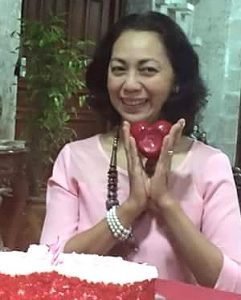The core of the Negros Museum is the Talamdan exhibit. The Talamdan is an assemblage of three distinct groupings that support the reason for the exhibit’s being.
Talamdan is a Hiligaynon word that means “record”. Hence, the exhibit is an archival one — made up of records and other evidences of transactions. It can also connote evidence of power explained by the fact that these records came about because Negros, as part of the Philippines, was part of the empire of Spain.
To emphasize Spain’s might in the political world, a sizeable stylized map of the Motherland shows Spain as a Queen garbed in a flowing cape. Etched on her body, on the cape, and on the background are the names of Spain’s colonies: the Americas, Africa, and the Philippines. (Bold) lines along the cape or skirt symbolize the trade routes.

Ang Simbahan kag ang Pagdumalahan
Religion was the greatest influence felt in the Philippines as a colony of Madre Espana. The first section of Talamdan holds mixed artifacts of blueprints and religious articles. It is Church and State working together in nation-building. In the province’s capital, the formal road network is credited to Fray Mauricio Ferrero, an Augustinian-Recollect priest from La Rioja, Spain, who became the parish priest of Bacolod City in 1871, in 1897, and in 1902. Padre Ferrero was also the builder of Puerto San Juan (the now-demolished old Provincial Jail), the Bacolod Public Cemetery, the first school of the Recoletos – the Colegio de San Jose, and the San Sebastian Cathedral.

To one’s right is the cathedra once used by Bishop Emeritus Antonio Y. Fortich (1967-1989), the very old wooden yoke of a bell, and a 19th century libro de bautizo with entries by Fray Ferrero himself. Appreciate the beautiful pensmanship of the cura parroco done in the era’s flourishes. A few paces ahead is a coralstone sample that shows the visitor the building material commonly used in Negros – the same stone one will find at the Hinigaran church of which a miniature model is displayed. These are powerful trademarks of the colonizer who used Christianity to encompass all aspects of colonial life (bajo la campana).

of the Talamdan Exhibit to include the Museo Diocesano artifacts was a small quiet affair last January 29, 2021.
A Sacred Heart of Jesus wooden statue becomes the point of transition from the first section into the second. It is carved out of santol wood (Sandoricum koetjape) which is a popular material among woodcarvers because it is easy to work with. A santol tree stump stands nearby as an actual sample of the material.

KAGULANGAN
The second and middle section of Talamdan represents the physical state of the island when the Spaniards came. The wealth of Negros at that time lay in its wilderness, hence, this gallery is all about land, and how the Spaniards documented it and everything in it. There were maps, inventories of wildlife and native trees and other flora and fauna, topographical features particularly of tributaries and mountain ranges.

Local artists take their inspiration from the environment, hence, the gallery holds artworks by Lino Severino, Tata Sevilleno, Jesus Bermudez, and local artisans all depicting natural features such as plains, Mount Kanlaon, migratory and native birds, and even mushrooms. The Spaniards’ treatment of our ancestral lands defied indigenous beliefs and traditions where our ancients held sacred their trees that were thought to be spiritual abodes. Two clay jars are samples of spiritual abodes the ancients would keep in their homes. The jars on display contrast each other – one simplistic and the other decorated – to show the evolution of the vessels from locally-made to an import that made its way into Philippine shores from China. Nature worship gave way to Western values, and the natives turned from their animistic religion to the church and the saints.
THE INDUSTRIAL AGE
With Christianity taking root in the island, the next natural step was to establish towns or settlements. These were arranged in the plano quadricula or the grid pattern, another typical feature in Spanish colonies.


Also, the haciendas were an offshoot of Spanish intervention in local agriculture. The Spaniards had a great influence on the prosperity of the island through sugarcane cultivation by the introduction of cane varieties that were suitable to the terroir. With the rise of the elite class in Negros came the legendary lifestyle of the sugar barons encapsulated in lavishly furnished mansions. With the new elite came the rise of the educated class who began to ponder on, and who began to question, the imbalance of power. The revolt was a natural and eventual occurrence. The Spaniards may have ventured forth to civilize an island, and inadvertently planted the seeds of destruction against them. The result is the ignominious event, the 5 de noviembre, that gained the Negrenses their independence. Negros became a republic long before the whole Philippines became known as the Republic of the Philippines. Viva la Republica Cantonal de Negros!
The Negros Museum is open from Monday to Thursday, 9:00 a.m. to 12:00 noon, 1:00 p.m. to 4:00 p.m., by appointment only. One group with a maximum of 15 persons may be allowed at one time. Entrance fee is at P100 per person. Call 7034339, or 4334764 for bookings.

